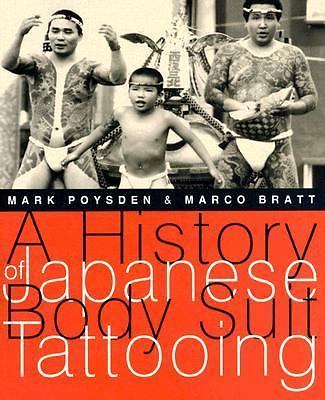Picture 1 of 6

Stock photo






Picture 1 of 6

Stock photo






History of Japanese Body Suit Tattooing by Mark Poysden and Marco Bratt (2006, Trade Paperback)
Y
yodaa666 (51)
100% positive feedback
Price:
$420.00
+ $45.00 shipping
Returns:
Condition:
The practice of punitive tattooing has existed for at least two thousand years globally. Japan was the last country to abolish it, in 1870. Tattooing was repeatedly abolished, without effect. Traces the history of the practice and artistry of body suit tattooing in Japan.
Oops! Looks like we're having trouble connecting to our server.
Refresh your browser window to try again.
About this product
Product Identifiers
PublisherBrill
ISBN-109074822754
ISBN-139789074822756
eBay Product ID (ePID)44180843
Product Key Features
Book TitleHistory of Japanese Body Suit Tattooing
Number of Pages224 Pages
LanguageEnglish
TopicAsian / General, BODYART & Tattooing, Asian / Japanese
Publication Year2006
IllustratorYes
GenreArt
AuthorMark Poysden, Marco Bratt
FormatTrade Paperback
Dimensions
Item Height0.7 in
Item Weight38.2 Oz
Item Length11 in
Item Width9 in
Additional Product Features
Intended AudienceTrade
LCCN2007-366471
Dewey Edition22
TitleLeadingA
Dewey Decimal391.650952
Table Of ContentPreface and Acknowlegements; PART ONE: THE HISTORIES: 1) Tokugawa Japan: The rise of feudalism; Tokugawa leyasu and his legacy; The class system; The collapse; 2) Life in Edo: Prostitution and the Yoshiwara; Fireman and the 'flowers of Edo'; Ukiyoe, 'pictures of the floating world'; Kabuki; Asakusa Temple and the Sanja matsuri; 2) The yakuza: Servants of the town; Tekiya and bakuto; New beginnings; Post-war years; The big three; Organisation and activities; PART TWO: TATTOOS: 4) Horikazu: Profile of a traditional Japanese tattoo artist; 5) Japanese Tattoos: The making of a Japanese tattoo; Prehistoric and tribal tattoos; Tattooing in China; The origins of figural tattoos; The influence of other arts; The modern era; 6) Motifs: Origins of Japanese iconography; Mythical animals; Animals; Religious and mythical figures; Historical figures; Flowers; Other motifs; Indices: Glossary and index of Japanese terms; English index; Bibliography.
Synopsis* Traces the history of the practice and artistry of body suit tattooing in Japan. * Highly illustrated: color and b/w photos and illus throughoutTattooing has had a long and sometimes dark life, particularly in Japan. The practice of punitive tattooing has existed for at least two thousand years globally. Japan was the last country to abolish it, in 1870. As elsewhere, the Japanese covered these marks of shame with decorative tattoos. The decorative designs became more elaborate as their popularity increased, largely as a reaction to strict sumptuary laws. Tattooing was repeatedly abolished, without effect. Even today, it is illegal to display tattoos publicly in Japan. In Japan, tattoos are primarily associated with the yakuza'organized crime. A History of Japanese Body Suit Tattooing traces the origins and development of the Japanese yakuza, ranging over their pre-WWII history, samurai and Bushido influences, the darker side of Tokugawa rule, and gambling connections and describing what happens when a highly regulated society disintegrates. The book then discusses the artistic influences on these designs. While acknowledging the impact of Kuniyoshi?'s famous print series on the art of tattoo, this book concentrates on other print artists who depicted tattooed heroes and kabuki actors. For instance, it profiles the tattoo artist Horikazu of the Asakusa district and includes numerous examples of his sketches and work, with explanations of Japanese motifs and techniques. It also comprehensively covers the history of the Asakusa temple complex and the Sanja Matsuri, the Shinto festival held in Asakusa which is a showcase for full body-suit tattoos adorning members of the variousyakuza gangs who reside in the district., The history of Japanese body suit tattooing is a fascinating one that encompasses much more that just the application of inks to skin. An understanding of the subject requires knowledge of the social and political forces at work from prehistoric times to the present day. This book traces the development of those forces, their role in the growth of the military government and its efforts to control a people often less than willing to be controlled. With reference to the Edo period (1600-1867), urbanisation and the growth of Edo (modern Tokyo), the background to tattooing is carefully explained. The yakuza (Japanese mafia), their forebears and their attitudes to life, crime and tattooing are explored in great depth. The technical aspects of tattooing are similarly detailed and Horikazu, a modern practitioner of this traditional craft, is profiled. The authors visited Japan at the invitation of one of Tokyo's yakuza gangs, where they also interviewed other tattoo artists and conducted research, and they have produced a book that will doubtless serve its field as an outstanding reference resource for a generation. Tattooing is again fashionable. The authors hope this book contributes to calls for some tattoo practices to be elevated to the realm of art, of which the Japanese body suit must be the supreme example. The authors visited Japan to complete their research by interviewing the bosses of two Asakusa gangs, the tattooist Horikazu as well as other tattoo artists and tattoo specialists. They accessed documents hitherto unpublished in a European Language and returned with much exclusive illustrative material. Book jacket.
LC Classification NumberGT2346.J3P68 2006
All listings for this product
Be the first to write a review




















